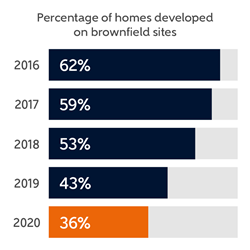Creating sustainable communities for both now and the future means ensuring that we protect, conserve and enhance the environments in which we operate.
For all of our individual site planning applications, where biodiversity and ecology need to be considered, we undertake a phase 1 desktop risk assessment. If the phase 1 Ecology Survey identifies any sensitive ecological issues we then look to undertake further ecological surveys in order to understand the overall impact and how this might shape the overall design of the site. If we are required to provide or implement any associated mitigation we will do so prior to, or during, the construction process. We seek to preserve or enhance the ecological interest of the land in which we develop. This through suitable mitigation or via biodiversity offsetting.
On sites where biodiversity impacts are potentially significant, we may need to carry out a detailed Environmental Impact Assessment (EIA). To determine whether this is required, we submit a ‘screening option’ to the Local Authority. This process allows us to take into consideration the environmental impacts of the development and take the necessary actions as advised by specialists. Subsequently we would submit a ‘scoping opinion’, which identifies the exact parameters of our assessment, so a true account of any impact can be measured. This allows us to again consider suitable mitigation, so as to seek to preserve or enhance the land which we develop.
Where required we carry out Habitat Surveys in order to ensure we do not have a significant adverse effect upon protected species such as bats, reptiles, newts, birds and badgers. Examples of our current measures to protect the biodiversity of our sites include:
We also contribute financially to assist in the protection of Special Protection Areas (SPAs) and where appropriate we have sought to introduce Environmental Management Plans which coordinate the introduction of ecological mitigation and enhancement measures both on site and in conjunction with sites which we are bringing through to construction.
Recent planning reforms, including the National Planning Policy Framework published in 2018, have placed a presumption in favour of sustainable development to ensure that local planning authorities identify and plan for the development which their areas need, and to make clear that applications that can prove to deliver sustainable development should normally be allowed.
We build a proportion of our new homes on brownfield land and this redevelopment can help to improve the local environment, as well as having a positive effect on the local community, helping to reduce crime, increase local employment and create green spaces. We enhance the creation of green spaces through the introduction of landscaping schemes, which not only improves drainage and biodiversity opportunities, but also provides customers with the opportunity to use and enjoy such spaces in the vicinity of their new homes, resulting in a more enjoyable place to live.
| Summary of performance |
|
186 active sites (58%) had some form of a biodiversity plan in place (2019 – 150; 44%) |
|
224 active sites (76%) had Sustainable Drainage Systems (SuDS) designed into the development (2019 – 255; 74%) |
|
Almost 13,000 trees were planted across our developments (2019 – 17,676) |
|
On average 29 trees and shrubs were planted for every home built (2019 - 30) |
|
36% of our homes were developed on brownfield sites (2019 - 43%) |
Performance data

